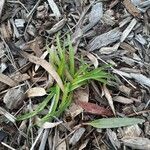A tufted lily which keeps growing from year to year. It grows 30-50 cm high and spreads 30 cm wide. The roots are fibrous. Some of the roots are fleshy and like tubers. They can be 4 cm long and 1 cm across. They are 4-10 cm below the ground. The leaves are 30 cm long by 1-3 cm wide. They are in dense tufts and can be grey. They are strap like. The flower stems are 50-100 cm long. The flowers are 2 cm across. The flower stalks are 1.5 cm long and they occur in twos or threes. They are on a leafless branched flower stem. The flowers are pale lilac or mauve. The flowers are star shaped and long stiffly spreading stalks. The stamens are densely white and hairy.

